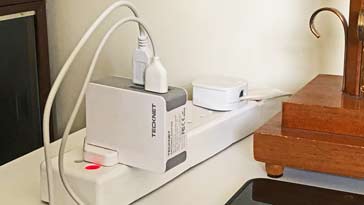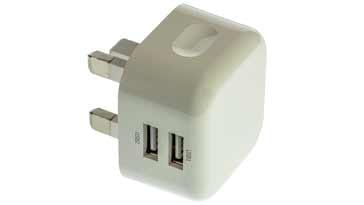How to Buy the Best USB Charger: including USB multiport charger
USB chargers come in many forms from single port to multiport chargers with a variety of output current capabilities - buy the best charger for your needs
USB Chargers Includes:
Buy best USB charger
Buy best car USB charger
Battery charges for AAA, AA, C & D batteries
Virtually all small electronic devices from mobile phones to batteries, iPods, iPads, tablets, portable gaming machines and many more all need charging.
In the early days of mobile phones and other similar equipment, each item needed its own battery charger and this resulted in everyone accumulating a huge number of different chargers which were not compatible with devices apart from the specific equipment for which they were supplied.

Nowadays, almost everyone has standardised on using USB chargers, often with a USB connector to interface with the electronic item, gadget, phone or whatever.
How do USB chargers work
Today USB chargers are remarkably small for the current they can supply. This means that even though these USB chargers are small and can fit into a small bag or briefcase without taking up much space, they can still charge up a number of items very quickly.
The chargers have a power supply within them. This utilises switch mode technology which provide for very low losses and small sizes.
Note on Switch Mode Power Supply:
Unlike linear power supplies which use a series pass device to dissipate the unwanted power, switch mode power supplies, SMPS, use an on or off switching element combined with capacitors and inductors to provide near lossless regulation and voltage conversion.
Read more about Switch Mode Power Supplies, SMPS
As USB chargers use switch mode power supply technology where the losses are very low (often 85% or more), little heat is dissipated and this means much smaller components can be used.
Another advantage of the USB chargers is that they are standardised. The voltage out is always 5 volts, and this means that a host of devices can use them. All the battery monitoring and charge completion circuitry is held in the device under charge - it just switches off the charge supply from the battery itself when it has finished.
Eco aspects of USB chargers
The eco aspects are often an important consideration when looking to buy a USB charger.
USB chargers are used almost daily as modern smartphones need recharging very frequently in view of the current drain caused by the screens, the processing and the RF communications.
It's not only smartphones that need recharging all the time, so do many other devices.

As a result of this chargers are often left plugged in and powered up all the time.
This could cause a small, but noticeable amount of energy to be used, especially when it is analysed over the whole 24 hour period and then over a year.
To combat this wasted energy usage, an initiative called the One Watt initiative was introduced.
The One Watt initiative was introduced by the International Energy Agency, IEA, with the aim of reducing the standby power usage.
It sought to reduce standby power usage by any electrical appliance to no more than one watt by 2010, with a further reduction to 0.5 watts in 2013. This has given rise to regulations in many countries and regions, and has resulted in a huge reduction in the amount of power consumed when devices are in standby.
Devices like USB chargers have benefitted from this any most modern USB chargers consume almost noting (less than 0.1 W) when nothing is connected to them. However if a device is connected but fully charged, the charger will still consume energy.
Some typical figures are given below:
| Power Consumed by a Modern Smartphone Charger |
|
|---|---|
| Usage | Power consumed (watts) |
| Charger plugged in, nothing connected | 0.0 |
| Charging | ~6.0 |
| Charged iPhone | ~0.9 |
How to choose the best USB charger to buy
There are many different USB chargers that are available from many stockists. Trying to buy the best one for any given purpose is not always easy, but by looking carefully at what is needed and what is available, the choice can become a little easier.
There are many points to note when choosing the best USB charge to buy for your needs.
- Number of ports: One of the major considerations when buying a USB charger is the number of ports that will be needed. There are chargers with 1, 2, 4, and even 8 or more ports. It is worth considering how many devices you might want to charge at any given time and then add a little more for future-proofing. That said, the more ports the higher the cost and larger it will be.
- Power output: The power output is normally measured in watts - the higher number of watts, the more power that can be supplied. Assuming the output is five volts and watts, = volts x amps, then it is easy to work out the total current. A 40 watt charger could give a total of 40 / 5 amps = 8 amps - but this is across all four ports. It is worth looking carefully at the limits for each port as you may want to have one or more ports that can support higher current levels. It is worth taking a good look at this before you buy a particular USB charger.
- Style / shape / colour: The style, size and shape may be important. If you want to slip the charger into a pocket, then a small one, typically with less ports may be the order of the day. However if space is not such an issue, then a larger one with more ports may be more suitable. Also the style and colour may be important for some - naturally this should also be considered.
- Brand name: Although brand name is not everything, sometimes it can imply a degree of greater reliability. That said, most USB chargers these days are very reliable.
- Intelligence: Many USB chargers incorporate intelligent technology and this enables tem to recognise the attached device and automatically deliver the correct amount of power. Other USB chargers can offer slow and fast-charging ports. You can then connect the phone, tablet of other device to the most appropriate output.
- Wall chargers: Wall chargers are a form of USB charger where the plug forms part of the main charger assembly and there is no wire from the charger to the mains or line power socket. In this way a wall USB charger will sit on the wall at the point of the mains socket. This may or may not be convenient for any particular situation.
- Input voltage range: If you travel and want to take the charger with you, make sure it can operate over the full voltage range of 100 to 240V. Most USB chargers will be able to achieve, this but it is worth checking as some on the market only operate at voltages down to about 180 volts. Also be aware that some that can operate down to 100 volts may have a small reduction in output current at this input level.
- Mains / line socket: Some USB chargers will have an adapter allowing the USB charger to directly plug into wall osckets wherever you are. It is often not a problem if you are travelling as it is likely that plug adapters will be needed anyway.
- Efficiency & standby power: Sadly these figures are often hard to find when investigating before buying a USB charger. Fortunately most modern USB chargers should consume virtually no power when plugged in with power applied, provided that no external device is connected as this will mean that the charger will be providing the ability to charge. The very low current standby mode is only activated when nothing is connected.
Before buying a USB charger, it is best to work out what you want. How much power is needed, and how many devices you may need to attach at any one time. Style, colour, size and various other aspects will then make the choice of which USB charger to buy much easier.
 Written by Ian Poole .
Written by Ian Poole .
Experienced electronics engineer and author.
More Equipment, Items & Gadgets:
Wireless charging
USB chargers
Power banks
E-readers
TV remotes
Webcam
Return to Electronic items menu . . .



